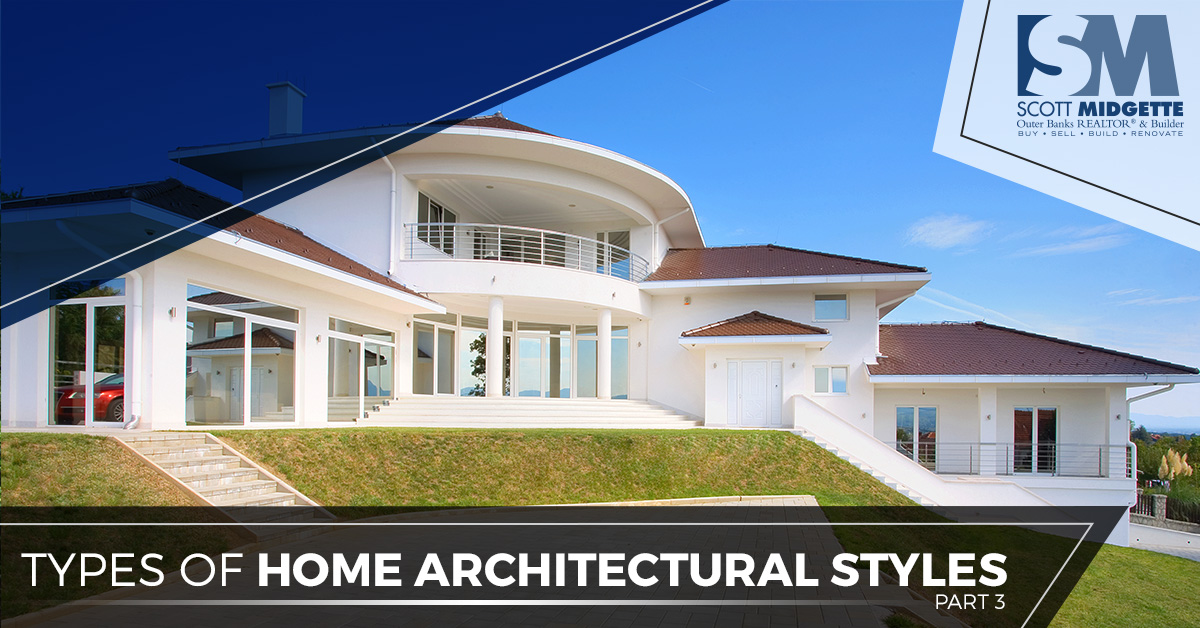Do you want to find the perfect home in the Outer Banks area? If so, Scott Midgette, Outer Banks Realtor can help. I have years of practice helping people from all over the world settle in to their perfect Outer Banks home. There is plenty of beautiful architecture here to choose from. If architecture is something that you are unfamiliar with, please enjoy part three of our Types of Architectural Styles series. So keep an eye out for the following styles.
Mid-Century Modern
Perhaps no architectural style captures the 20th century quite so much as Mid-Century Modern. In fact, Mid-Century Modern refers to much more than just architecture, but also products, interior design, graphic design, and styles of urban development from the period between 1933-1965, when the style reached its height. It was at its most popular after World War II, where it was employed in residential neighborhoods around the world to convey the technological innovation of our country.
Modern
Building on the Mid-Century Modern style, and coming to prominence right after it, the Modern style is still reaching its height of popularity. It makes use of all the modern technological and architectural innovations of the 21st century to bring in new materials, styles, and functionality to the homes of today. The style contrasts greatly with Victorian era homes, which are made to look lavish and eclectic. Modern homes still aim for the high functionality of a Victorian home, but without the wasteful excess popular from the time.
Northwest
Northwest, and Northwest Regional, style of architecture hit the Pacific Northwest in its rise to prominence during the period between 1935 to 1960. It is a regional variant of the International Style, and makes heavy use of textured, unpainted wood (both on its exterior and interior). Other hallmarks of this style include an asymmetrical layout, low pitched shingle roofs with overhanging eaves, floor level glass, and little ornamentation. The term “Northwest” in reference to a style of architecture was coined by John Yeon.
Ranch
Ranch architecture ranges heavily from region to region, but is typical for houses on large rural areas. Popular forms of Ranch architecture include American Ranch, Rambler, and California Ranch. A minimalist style that makes use of a wide, dense ground profile, Ranch style homes are a staple of the American Western period. This style gained its height of prominence between the 1940s and 1970s, and would be exported all across the world until its popularity started to decline by the beginning of the 21st century.
Spanish
Spanish architecture, like many architectural styles, reflects the community that created it. Spanish culture is largely family oriented, and the architecture reflects that. Spanish villas are very close together, and are multi story buildings, reflecting the common practice of housing entire generations of families. Spanish architecture reached its height around the same time Christianity did in the area, and reflects many architectural styles from Christian, Muslim, and Jewish schools. In fact, many aspects of smaller Spanish homes can be seen in Spanish castles and churches from the same era.
Southern
Southern architecture is also known as antebellum architecture, meaning “before the war”. It came to prominence after the American Revolution, and stayed popular until the start of the Civil War. Characterized by the large plantations of the time, Southern houses doubled as management buildings for wealthy farmers and slaveholders. Southern style buildings are huge sprawling architectural marvels, with many stylistic nods from Georgian, Greek Revival, and Neoclassical schools of architecture.
Traditional
When you think of a house from a 50s or 60s television show, a Traditional style home probably comes to mind. Modeled after Tudor house plans, Traditional homes have a front gable, immense chimney, a low pitch roof, and elaborate detailing. Traditional homes are known for their simplicity, boasting comfortable yet spacious single level floor plans. They generally have stucco exteriors and a hipped roof. Other less common features of Traditional homes include open foyers, covered porches, varying roof pitches, and lofts.
This concludes my three part series of popular architectural styles from around the world. I hope you found it informative, and now when you come see the homes I have for sale here in the Outer Banks, you can say without a doubt that they are the most beautiful in the world! Don’t believe me? Check out some of my listings posted online. If you have any questions about any of our posted properties, please do not hesitate to give me a call at your earliest convenience. I will be happy to provide you with answers to any questions that you may need.







